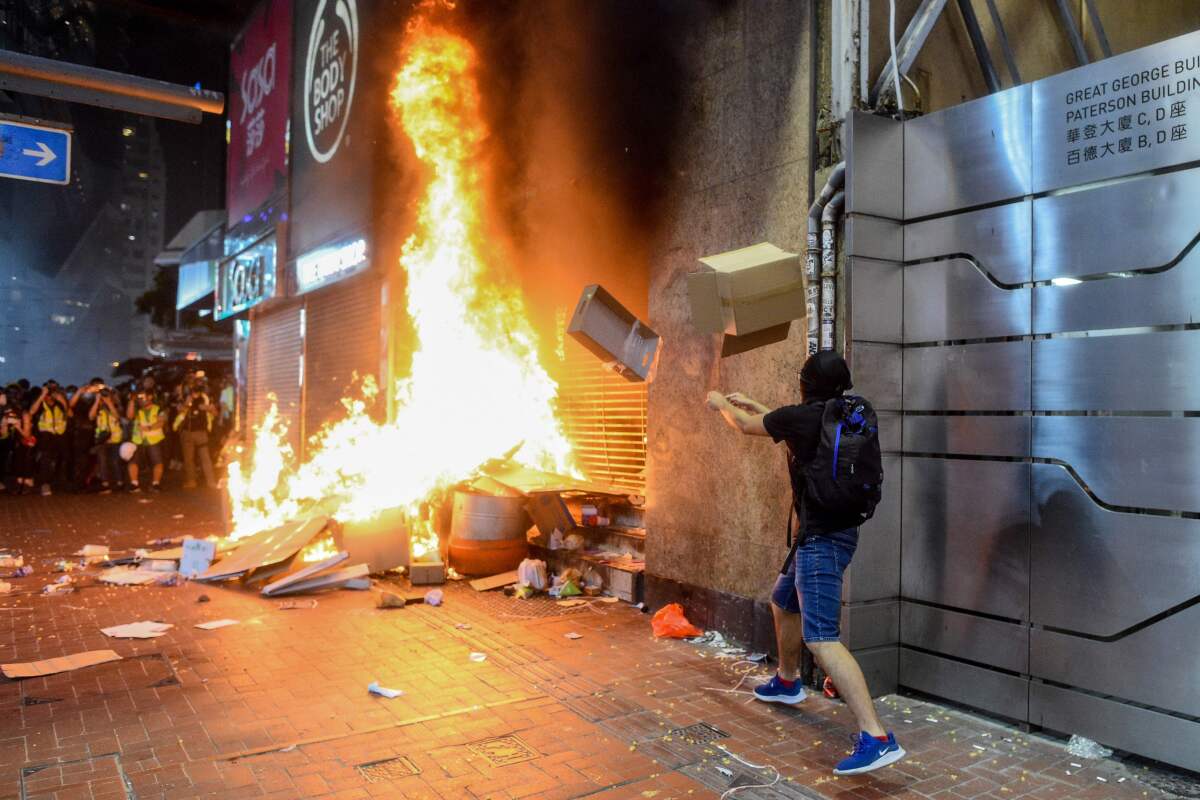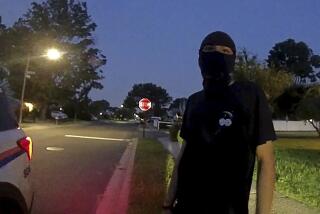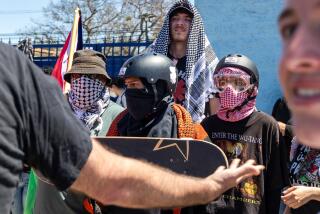‘Hong Kongers, resist!’: A new cry as 14-year-old is shot by a cop and masks are banned at protests

- Share via
HONG KONG — A 14-year-old was shot with live ammunition by a plainclothes police officer Friday — the second young protester to be shot by an officer with a live bullet this week — amid violent and chaotic protests as Hong Kong’s chief executive invoked a colonial-era emergency law to ban face coverings at public gatherings.
Ugly clashes broke out in the suburb of Yuen Long, where the teen was shot.
A video circulated on social media showed black-clad protesters beating and throwing a fire bomb at a plainclothes police officer in a white T-shirt, who then leaps out of the flames and drops a handgun on the ground. Local media reported that the policeman had shot a teenager.
Medical authorities confirmed that the 14-year-old protester was shot in the leg by live ammunition and hospitalized. Police issued a statement that an officer had fired a live round, but only because “his life was under serious threat.”
Meanwhile, two activists launched a last-ditch effort to obtain an interim injunction against the mask ban, which went into effect at midnight. The High Court rejected the request just after 11:30 p.m.
Under the new regulation, anyone who wears a mask or paint obscuring their face during a public assembly, whether authorized or not, could face a fine of more than $3,000 and imprisonment for one year. It is a move squarely aimed at protesters who have taken to the streets for four months.
Chief Executive Carrie Lam said at a news briefing Friday that the law was intended to “create a deterrent effect against masked violent protesters” and “assist the police in law enforcement.”
As she spoke, thousands of protesters poured into the city streets, chanting, “Hong Kongers, resist!” and “Disband the police!”
Some burned Chinese flags and patriotic banners. Others vandalized restaurants reputed to be pro-Beijing. Many were spontaneous protesters coming out of school, work or home: office workers in suits, elderly couples, children in school uniforms, and men and women carrying laptops or purses.
Almost everyone wore a mask.
Invoked under an emergency law that gives draconian power to the territory’s chief executive to implement “any regulations whatsoever which he may consider desirable in the public interest,” the announcement sparked fears that Hong Kong was slipping toward martial law.
“Carrie Lam wants to turn Hong Kong into China. This is only the start. Next, they censor the media, monitor our communications online, reporting people,” said Samuel, 18, a protester in a full-face mask who, like other protesters, asked not to use his full name for protection from authorities. “We have no way to keep ourselves safe anymore.”
The new law comes as public fury at Hong Kong’s police and government is at an all-time high, fueled by anger over police shooting protester Tsang Chi-kin, 18, in the chest on Tuesday, China’s National Day. Tsang, a high school student, has since been charged with rioting, an offense punishable by up to 10 years in prison.
While radical protesters have smashed government buildings, set street fires and thrown gasoline bombs and bricks at police, public opinion remains overwhelmingly supportive of protest demands — independent investigation of the police, amnesty for arrested protesters, to stop calling protests “riots,” and universal suffrage.
A recent poll by the Chinese University of Hong Kong shows that 69% of respondents blamed Hong Kong’s government or police for increasing violence. Anger toward Lam’s administration has increased since Tuesday’s shooting, with thousands of protesters rallying daily to demand accountability — and the mask ban is fuel on the fire.
“Carrie Lam is declaring war on us with this law. If she wants a war, bring it on,” said Emma, 22, a protester in jeans and a black surgical mask. “She thinks she’s the queen of Hong Kong but now she’s only Xi Jinping’s puppet. If we burn, she burns with us.”
“Of all the available options, you can always trust the government to choose the worst one,” said June, 32, who said she didn’t usually protest but had stepped out of her office to join the crowds. “They have no idea how to de-escalate the situation and I’m afraid of what will happen next.”
Charles, 38, an office worker in a buttoned-up shirt and a surgical mask, said he planned to wear a mask every day from now on.
“People will find creative ways to circumvent it, like saying they’re sick or the air quality is bad or they’re wearing religious dress,” he said. “Giving herself and the police more power won’t restore order. It’ll only lead to greater uprising.”
Lawmakers and academics say the mask ban is the first step in a potential slippery slope toward virtual martial law in Hong Kong, empowered by a colonial emergency law that gives essentially dictatorial power to the chief executive.
Created in 1922 so the British could suppress Chinese seamen who were on strike over unequal wages, the Emergency Regulations Ordinance has only been used once since, in 1967, to quell Cultural Revolution-inspired leftist riots that involved hundreds of bombings and dozens of deaths.
The law gives the government the power to carry out arrest, detention, deportation, censorship of media, seizure of property, search and entry of premises, control of ports and all transportation, suppression of publications and communications, and anything else short of the death penalty deemed “in the public interest.”
“It’s not really about the masks and it’s not really about the ban. It’s about setting a precedent for using emergency power,” said Leung Kai-chi, a professor at the Chinese University of Hong Kong’s Center for China Studies.
Using executive power to declare an anti-mask law brings Hong Kong back to where the protests started, Leung said, with people’s fear and frustration over an unwanted extradition bill that would have allowed deportation of suspected criminals to China.
“The whole fiasco comes from the government pushing through legislation, and they are doing it again,” he said, adding that protesters are already risking 10 years in prison on charges of rioting, yet hundreds of thousands continue to rally each week.
“Adding another charge on top of it is not going to make people stop or go home.”
“If there are 10,000 people on the street and everyone wears a mask, what do you do? You shoot them on sight? Or what? Round them up and arrest them all? This is obviously useless,” said pro-democratic lawmaker Charles Mok.
He said he expected the government to later declare the mask ban ineffective and escalate to a curfew, possible internet shutdown and other controls. Meanwhile, without a legal way to resist the government’s emergency powers, people would resort to further civil disobedience.
John Burns, former dean of the faculty of social sciences at Hong Kong University, said emergency regulations were an attempt to snuff out protests with force rather than address their cause: Hong Kong authorities’ lack of response to its citizens, and citizens’ inability to participate in the political process.
“Banning masks is not a political solution,” he said. “You can suppress all you want. It won’t work. We need a redistribution of power within Hong Kong.”
Protesters have donned surgical masks throughout the protests to protect themselves from being identified through cameras or facial recognition technology ubiquitous in mainland Chinese surveillance. More than 1,750 protesters have been arrested so far, some taken from their homes or hospitals in days after protests.
They’ve also worn respirators and gas masks — as have medics and journalists — as police use large amounts of tear gas and pepper spray on the crowds.
Police also wear masks as part of their riot control gear. Many have stopped displaying their ID numbers in order to prevent their identities from being posted online by protesters, a practice known as doxxing.
A spokesperson for Beijing’s highest policy office dealing with Hong Kong said in a statement Friday evening that the mask ban was “legal, legitimate and reasonable” and “absolutely necessary.”
Lam denied that the law was a directive from the Chinese government. She said at the briefing that she had “absolutely no interaction with any central officials on this matter” during her trip to Beijing for the National Day celebration earlier this week.
She also said that invoking the emergency law does not mean Hong Kong is in a state of emergency — possibly to ward off questions about Article 14 of Hong Kong’s basic law, which allows the People’s Liberation Army to assist the Hong Kong government in the “maintenance of public order” if requested.
“We are not proclaiming that Hong Kong is entering a state of emergency,” Lam said.
As midnight approached, protests built into a rampage across the city, shutting down the entire subway system.
Some protesters read out various declarations of interim government, announcing self-determination and rejecting recognition of the Hong Kong police and government. Others set fires at subway stations, mainland Chinese businesses and banks.
When the clock ticked past midnight, most protesters had vanished from the streets. Riot police entered the hospital where the injured 14-year-old was undergoing surgery.
Bystanders cursed at the officers, who covered their faces with masks.
Special correspondent Ho Kilpatrick reported from Hong Kong and staff writer Su from Beijing.
More to Read
Sign up for Essential California
The most important California stories and recommendations in your inbox every morning.
You may occasionally receive promotional content from the Los Angeles Times.











